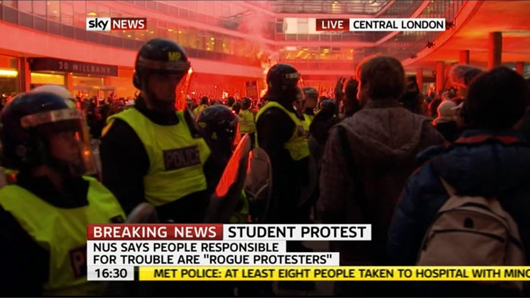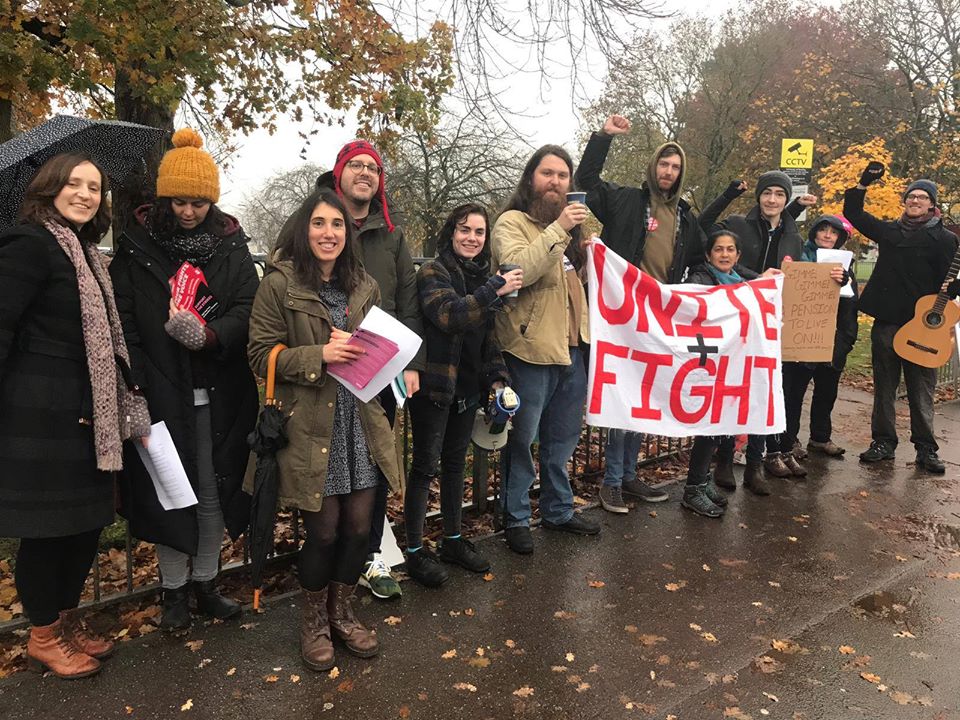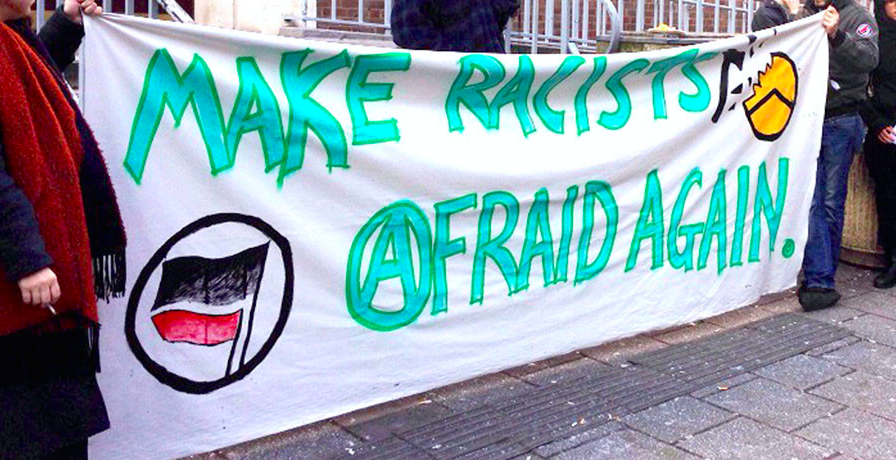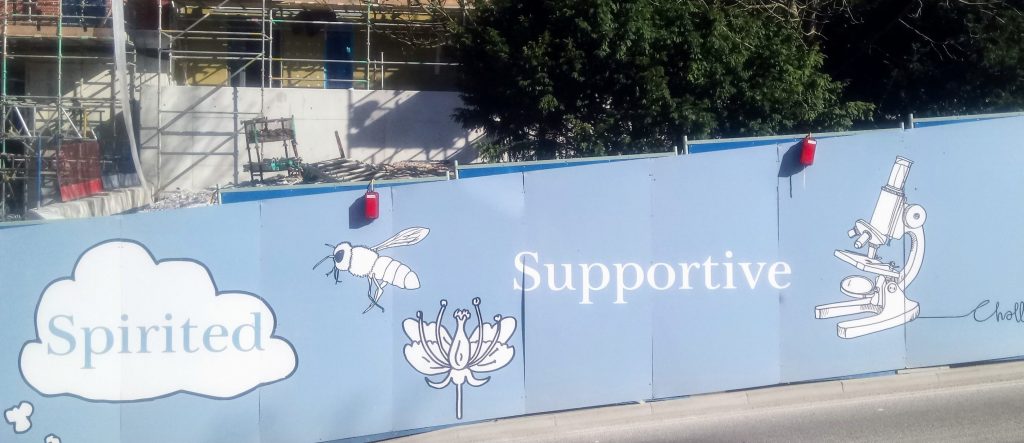By Nicholas Beuret
What has been taken from them to make them so angry? Hope, that’s what. Hope, and the fragile bubble of social aspiration that sustained us through decades of mounting inequality; hope and the belief that if we worked hard and did as we were told and bought the right things, some of us at least would get the good jobs and safe places to live that we’d been promised – Laurie Penny, New Statesman
A single image from a day of movement marks out competing visions of hope. A boot through a Millbank window fed the dreams of resistance that many in the Left have been craving since talk of austerity started. The same boot posed a question that plays out in the university occupations that preceded it and have since blossomed in its wake: what is it exactly that we are hoping for?
The question of how students have inspired people to act, engage and organize to combat the Government’s austerity plans is an important one. It is one that also potentially contrasts with some of the views of students themselves. For let’s be clear – it is not necessarily (or even principally) the University or its defence that mobilizes people’s desires and dreams outside the student movement. Defending the ‘right to education’ may be what sparked student revolts, but those of us who are not students have been drawn in because we want, more than anything, to resist and fight. And to resist and fight you need to know that resistance is possible, that you will not be alone, and that you can win. For the most part the resistance so far to the regime of austerity has been rote and uninspiring – a betrayed strike here, a sacked workforce there.
Minor victories and thousands of words spoken of an inevitable uprising, of an insurgency against the restructuring. The boot through the window took us beyond the rhetoric and yearnings. It showed rage and the will to fight. It showed cops overwhelmed and underprepared, Tory offices ransacked and the beautiful excess of an insurrectionary moment. It inspired because it was truly magical, and people saw for themselves that battles could be waged, people would fight, and winning was possible.
But beyond this what support is there for the ‘right to education’? For this was the starting point for the riot and the thread that binds the demonstrations, the walkouts and the occupations. Cutting the Education Maintenance Allowance, shedding whole university departments and countless staff, and raising fees. The restructuring is an attack on ‘education’ as it exists in the University; a wholesale revision of who can access what. It is perhaps taken for granted that ‘we’ all support the right to education, and that we are all united in our defence of the University. But what if we are not?
What if it is our rage and not our hopes that are united? What if we are together only for the fight, but not the victory?
Hope becomes scarce
Laurie Penny nails the motivation behind the riot – hope. Or rather, the restructuring of hope and its coming scarcity. A restructuring and scarcity because hope is not something eternal or ephemeral. Hope is a material thing, produced and distributed through social channels and institutions. Institutions like the University.
What do we mean by a socially produced hope? Different societies produce different kinds of hopes. In fact, every single society produces different kinds of hopes. Hope is a mobilizing and organizing force that structures the direction and possibilities of our lives. As memory shapes our understanding of the past and how we understand what we are now, hope shapes our understanding of the future – what there will be, what there could be, who and how we will become something more than we are today. Both hope and memory give form and purpose to our actions; they give our lives meaning.
There are competing versions of hope in a given society, but there is also a hegemonic form to hope. For us, living in a becoming-neoliberal world, that hegemonic form is aspiration. Not aspiration in the sense to aspire to greatness in some heroic Greek sense, or something romantic and colourful. No, for us aspiration has a particular hue and tint – it means social mobility. It means a better job, more money, more things and a higher rung on the career ladder. Hope is individual in our world, never collective – the hope of entrepreneurs dreaming of making it big. Not just climbing the ladder but also winning out over all others. We hope for social mobility. Which is exactly how Penny frames it, as do most of the placards on the streets. Hope, the dominant form of hope, is to do better than your parents.
Hope is not evenly distributed – what hopes there are and who has access to them depend on where you are located (be you poor, or black, disabled, a women, young, living in the regions, etc). Neoliberal hope – aspiration – is increasingly restricted to an ever-smaller circle of people: those people doing well through the current crisis; those people above the buffer of the ‘squeezed middle’. For the rest, there’s the lottery. (To be clear, there have been ‘no hopers’ for quite some time – an underclass living a kind of social death of meaningless, pointless lives, hidden away behind ASBOS on estates [1]. But this is to become the norm for many, many more people).
This in turn leads to a scarcity of hope and an increasing number of people subject to a social death – a life defined as without future and therefore without meaning. A life trapped with nowhere to go. This generates a crisis of hope that can manifest in a number of ways. The most obvious is resentment against those who seem to still have hope. It is also visible in the desperate attempts to salvage some hope – through the memories of privileges of nationality, race and gender (such as mobilized by the BNP).
The current crisis marks a turn from a mixed economy of hope – where neoliberal policies and subjectivities press up against older forms of entitlement and ideals of fairness and social mobility. We are living through the birth pangs of a truly neoliberal age where meaning, hope and the future itself are scarce and out of reach for most of us. It is here, at the juncture of a new social order and the collapse of the remaining entitlements of the welfare state, that the restructuring of hope comes to be generally seen as a crisis of hope. We are entering an age of scarcity of the future.
It’s clear that the students are revolting against the loss of this hope and future. Social mobility (as such actually exists) is under attack. The ‘squeezed middle’ and their children will become, like the existing underclass, a footnote to the bigger and brighter stories of the well-to-do professionals. The student revolt speaks to us all as the first open revolt against the expansion of social death and the collapse of the more general circulation of aspiration. So the loss of entitlement is real, and the revolt is too. But we should stop here and ask if that is the end of the tale told by the boot. Did that kid kicking in the window really just want to be better off than his parents? Did he really want to keep the University as it stands?
Aspiration and the right not to be working class
Let’s go back to the idea behind neoliberal aspiration – social mobility. Social mobility means getting ahead, doing better than your parents and your peers: it means that while you move other people have to stand still. Social mobility requires both winners and losers. Hope – or aspiration – confirms the unequal world in which we live. And education – that formal process of differentiation, where some end up with degrees and contacts and others jobs without a future – is essential to the creation and maintenance of that inequity. It reinforces the role of the University in unequally distributing meaning, possibilities, wages and other forms of social wealth. Put this way, the right to education means the freedom to be unequal. The right to education works to underpin the myth of meritocracy – the myth that it’s through hard work and ability and not connections, class and privilege, that people get to where they are. The right to an education means that if you perform well in standardized tests (helped by being well off, going to the right school and having a stable family life) then you deserve to go to University and cement your place up near the top of the social hierarchy (as long as you make it into a relatively decent university, though how many ‘bad’ ones will remain after the cuts is an open question). The betrayal of the right to education – by either there not being enough jobs for graduates (as is the case for a third of existing graduates), or by the rising costs of ‘earning’ a degree, putting it out of reach for all but the very wealthy – is the betrayal of the right to not being working class. Looking at it this way, through the broken glass, we can see that the riot went beyond mere aspiration. Just as the university occupations have gone beyond the simple question of the ‘right to education’. The joy to be found in revolt overflows the boundaries of a pedestrian desire to get ahead.
But here both we (both we who are students and we who are not) find ourselves in a double bind. We need to defend mobility in the world as it stands – its defence is the defence of actual existing lives and the real possibility to have a meaningful social existence. And we need to defend the funding of education as it stands. To resist paying more for education is to defend the social gains made by previous generations and to defend the social wage. And defending it is exactly what many students (and many of their supporters) are doing. But in merely defending it we are in fact defending the most sacred of neoliberal freedoms – the freedom to be unequal. Defending this freedom means defending the University as a filtering device set up to segregate us into educated and not; those with access to a ‘professional career’ and those who do not. Those with meaningful lives and those without.
Hopes against hope
So we must go beyond mere defence. The riot is as much about dreams that have yet to become possible as they are over the loss of existing entitlements. There are hopes that lie dormant or hidden that speak of different ways of being; of different kinds of dreams and futures. The crisis of hope and the coming scarcity of the future for many people is a betrayal that makes possible a different kind of hope – a hope against hope, violently against aspiration and cold conformity.
The student revolts then are the fracture in the facade. Students sense that not only are their lives changing, but that the myth of mobility that has underpinned the University in recent years is coming undone. These protests are the first protests in Britain to contest the changing meaning of hope, and the austerity of dreams that is the coming neoliberal future.
But to be honest and faithful to the riot and the promise of a different kind of hope, an act of betrayal is needed. A betrayal of the University and education as it stands. For here we come full circle.
For if the protests and occupations speak only of the importance of education, and the necessity to defend the University, people will quickly fall away. People can see clearly what the University is now.
The window is broken. We can see clearly that the University is a machine that creates social death.
Eventually the inspiration of the initial fight and victory will fade, and the content of the revolt will have to stand on its own. If the content of that struggle is only to restore that machine, to defend the freedom to be unequal, failure is all we can hope for.
But if the struggle calls into question the very existence of such a machine, and reopens the question of learning as opposed to education – to self-development, the exploration of interest and inclination, and to allow for the navigation of curiosity and desire; in short, learning as a way of creating new possibilities and meaning, new practices and forms of relating and organising – then the window may stay broken for a long time to come.
– Feb 2010
——
[1] I am talking of the hegemonic form of hope here. Those devoid of hope in the conventional normative sense often resist through the production of alternative visionings and dreams; other kinds of hopes and socialities, often rejecting outright the binds to convention and the ethics-of-aspiration





